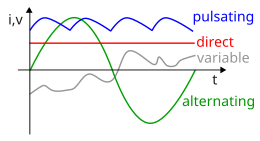
Back Wisselstroom Afrikaans Wechselstrom ALS አመንቺ ጅረት Amharic Corrient alterna AN تيار متردد Arabic Corriente alterno AST Dəyişən cərəyan Azerbaijani Пераменны ток Byelorussian Зьменны ток BE-X-OLD Променлив ток Bulgarian
This article needs additional citations for verification. (March 2023) |

| Articles about |
| Electromagnetism |
|---|
 |
Alternating current (AC) is an electric current that periodically reverses direction and changes its magnitude continuously with time, in contrast to direct current (DC), which flows only in one direction. Alternating current is the form in which electric power is delivered to businesses and residences, and it is the form of electrical energy that consumers typically use when they plug kitchen appliances, televisions, fans and electric lamps into a wall socket. The abbreviations AC and DC are often used to mean simply alternating and direct, respectively, as when they modify current or voltage.[1][2]
The usual waveform of alternating current in most electric power circuits is a sine wave, whose positive half-period corresponds with positive direction of the current and vice versa (the full period is called a cycle). In certain applications, like guitar amplifiers, different waveforms are used, such as triangular waves or square waves. Audio and radio signals carried on electrical wires are also examples of alternating current. These types of alternating current carry information such as sound (audio) or images (video) sometimes carried by modulation of an AC carrier signal. These currents typically alternate at higher frequencies than those used in power transmission.
- ^ N. N. Bhargava & D. C. Kulshreshtha (1983). Basic Electronics & Linear Circuits. Tata McGraw-Hill Education. p. 90. ISBN 978-0-07-451965-3.
- ^ National Electric Light Association (1915). Electrical meterman's handbook. Trow Press. p. 81.
© MMXXIII Rich X Search. We shall prevail. All rights reserved. Rich X Search